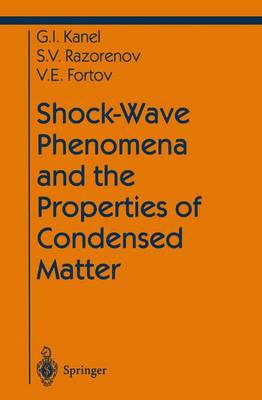Shock Wave and High Pressure Phenomena
3 total works
Spall Fracture
by Tarabay Antoun, Lynn Seaman, Donald R Curran, Gennady I Kanel, S V Razorenov, and A V Utkin
Published 1 January 2003
Shock-induced dynamic fracture of solids is of practical importance in many areas of materials science, chemical physics, engineering, and geophysics. This book, by an international roster of authors, comprises a systematic account of the current state of research in the field, integrating the large amount of work done in the former Soviet Union with the work done in the West.
Topics covered include: Wave propagation, experimental techniques and measurements, spallation of materials of different classes (metals, ceramics, glasses, polymers), constitutive models of fracture processes, and computer simulations.
Topics covered include: Wave propagation, experimental techniques and measurements, spallation of materials of different classes (metals, ceramics, glasses, polymers), constitutive models of fracture processes, and computer simulations.
Shock-Wave Phenomena and the Properties of Condensed Matter
by Gennady I Kanel, Sergey V. Razorenov, and Vladimir E. Fortov
Published 30 March 2004
One of the main goals of investigations of shock-wave phenomena in condensed matter is to develop methods for predicting effects of explosions, high-velocity collisions, and other kinds of intense dynamic loading of materials and structures. Based on the results of international research conducted over the past 30 years, this book is addressed not only to experts in shock-wave physics, but also to interested representatives from adjacent fields of activity and to students who seek an introduction to the current issues. With that goal in mind, the book opens with a brief account of the theoretical background and a short description of experimental techniques. The authors then progress to a systematic treatment of special topics, some of which have not been fully addressed in the literature to date.
High-Pressure Shock Compression of Solids VII
by Vladimir E. Fortov, L.V. Altshuler, R. F. Trunin, and A.I. Funtikov
Published 8 April 2004
Presenting some of the most recent results of Russian research into shock compression, as well as historical overviews of the Russian research programs into shock compression, this volume will provide Western researchers with many novel ideas and points of view. The chapters in this volume are written by leading Russian specialists various fields of high-pressure physics and form accounts of the main researches on the behavior of matter under shock-wave interaction. The experimental portions contain results of studies of shock compression of metals to high and ultra-high pressure, shock initiation of polymorphic transformations, strength, fracture and fragmentation under shock compression, and detonation of condensed explosives. There are also chapters on theoretical investigations of shock-wave compression and plasma states in regimes of high-pressure and high- temperature. The topics of the book are of interest to scientists and engineers concerned with questions of material behavior under impulsive loading and to the equation of state of matter. Application is to questions of high-speed impact, inner composition of planets, verification of model representations of material behavior under extreme 1oading conditions, syntheses of new materials, development of new technologies for material processing, etc. Russian research differs from much of the Western work in that it has traditionally been wider-ranging and more directed to extremes of response than to precise characterization of specific materials and effects. Western scientists could expect to benefit from the perspective gained from close knowledge of the Russian work.


